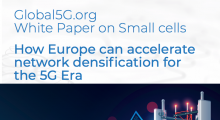Satellite: an enabler of 5G Verticals and Technical Viewpoints
Overview of ESOA
The EMEA Satellite Operators Association (ESOA) is the world’s only CEO-driven satellite association, which serves and promotes the common interests of satellite operators that deliver information communication services across the globe. Satellite operators represent two thirds of the entire space economy (valued at 250 billion dollars in revenue) and creates over 900 000 direct jobs worldwide.
ESOA is committed to a cooperative approach between mobile and satellite players to accelerate 5G objectives, whether by bridging the digital divide or providing communications for high-tech industries. Its satellite network supplier ecosystem is already pro-actively working in 3GPP to enable the end-to-end integration of satellite into 5G deployments.
ESOA is a 3GPP Market Representation Partner (MRP).
5G Value Proposition
5G will be a network of networks - an ecosystem - with multiple technologies supporting a global infrastructure: satellite, Wi-Fi, small cells, and traditional mobile wireless networks, among others. Satellites have a particularly important role to play bringing services to users quickly, no matter where they are located and no matter the availability of terrestrial infrastructure. Satellites have three key characteristics that are critical for the success of 5G: wide area and highly focused coverage, cost-effectiveness, and reliability (resilience).
Viewpoints from Ammar Khan, Inmarsat and ESOA (July 2019 with updates in January 2020).
Satellite is an important enabler of 5G use cases and vertical industries through a wide variety of communication capabilities: fixed, broadcast and mobile. Multiple verticals mean multiple slices and solutions. Examples of verticals benefitting from NTN are: Agriculture, disaster recovery, mining, oil and gas, maritime communications, as well as cellular backhaul and secure communications.
In international standards, satellite falls under the term Non Terrestrial Networks (NTN), which refers to networks, or segments of networks, using an airborne or spaceborne vehicle for transmission.
5G Pillars for verticals
Verticals are targeted depending on where satellite can bring value through any of these 5 pillars.
-
Ubiquity: High-speed capacity worldwide with key enablers: capacity in-fill for geographic gaps, overspill to satellite when terrestrial links are over capacity, general global wide coverage, back-up/resilience for network fall-back, and communication during emergencies.
-
Mobility: Satellite is the only readily available technology capable of providing connectivity capable of providing connectivity anywhere on the ground, at sea, in the air for moving platforms, such as airplanes, ships and trains. When it’s up, it’s available.
-
Broadcast (simultaneity): Satellite can efficiently deliver rich multimedia and other content across multiple sites simultaneously by using broadcast and multicast streams with information centric networking and content caching for local distribution.
-
Security: Satellite networks can provide efficient solutions for secure, highly reliable, rapid, and resilient deployment in challenging communication scenarios, such as emergency response.
-
Reliability: Highly reliable systems with connected availability at 99.9%.
Satellite use case categories for 5G
-
Trunking and head-end feed: high-speed trunking of video, IoT and other data.
-
Backhauling and Tower Feed: high-speed backhaul connectivity to individual cells.
-
Communications on the Move: high-speed backhaul connectivity to in-motion terminals.
-
Hybrid multiplay: high-speed connectivity including backhaul to individual homes and offices.
Success Factors
-
Tackling challenges around opening up to a wider ecosystem.
-
Interoperability is a key enabler for both satellite and terrestrial.
-
A common 5G architecture can only be achieved where it is technically possible. Satellite systems are not a single vertical. Hence some technologies work for broadband while others are better suited for low data rate services. Satellite industry focus on verticals is focused on those industries where satellite can bring added value.
-
Picking up the right use cases and technologies are key to accelerating satellite/terrestrial integration.
Standardisation Inputs
-
The involvement of satellite in RAN/SA will help opening up to the wider ecosystem.
-
There is clear engagement from the satellite industry on NTN scoping for Rel-17.
-
Standardisation would bring economies of scale, interoperability and integrated services.
-
ESOA is taking small steps, where the short/mid-term strategy is key to de-risk and accelerate satellite/terrestrial 5G services.
Standards enabling satellite integration into 5G
-
3GPP SA - Service requirements associated with satellite access and transport included in TS 22.261 - Service requirements for the 5G system; Stage 1.
-
Ability to manage and deploy 5G services with 3GPP or non-3GPP satellite radio access network.
-
Study Items (SIs) targeting Rel-17 specification.
-
TR 28.808: Study on Management and orchestration of integrated satellite components in 5G network.
-
TR 23.737: Study on architecture aspects for using satellite access in 5G.
-
-
3GPP RAN - Study Items targeting Rel-17 specification.
-
TR 38.821: Solutions for NR to support non-terrestrial networks (NTN).
-
-
Current targeted services are eMBB.
-
More than 50 supporting organisations from vertical, cellular and satellite industries, as an example of how NTN is gaining momentum.
Other relevant standards organisations for Network Management & Orchestration: ONAP (Open Network Automation Platform); The Linux Foundation; MEF; ETSI Satellite Communications; ITU; CEPT (European Conference of Postal and Telecommunications Administrations).
European contributions: Standardisation efforts are partially funded by Horizon 2020 SAT5G/5G ALL-STAR; SATis5; 5G-VINNI; ESA ALIX (SSIG), METAMORPHOSIS and individual corporate members of ESOA.



